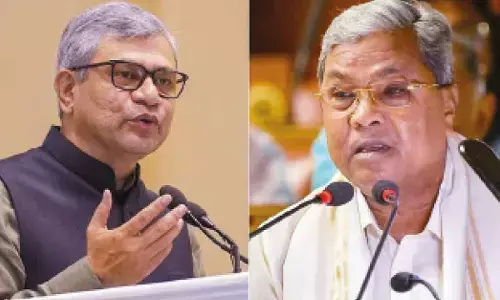Modi magic

Modi magic. After 30 years, the Indian voters have given a decisive verdict. In 1984, it was a sympathy wave in favour of Rajiv Gandhi, who became Prime Minister following the assassination of his mother Indira Gandhi.
After 30 years, the Indian voters have given a decisive verdict. In 1984, it was a sympathy wave in favour of Rajiv Gandhi, who became Prime Minister following the assassination of his mother Indira Gandhi.
In that sense, the 2014 election has been a turning point with the Bharatiya Janata Party (BJP), led by Narendra Modi, winning the people’s mandate surpassing all expectations. Yet, in the final analysis it is not clear whether it was a Modi wave or an anti-Congress wave that was blowing across the country. The ignominious defeat of the Congress suggests that the negative votes of the Congress went in favour of the BJP or Modi. And despite the high profile campaign criss-crossing the entire country by Modi, regional parties like the AIADMK, Trinamul Congress, Biju Janata Dal and TRS have improved their number of seats. If it was a Modi wave, it could have swept away all other parties.
Interestingly, in Uttar Pradesh and Bihar, the Modi juggernaut had crushed all that came its way, with Samajwadi getting 5 seats, Congress 2 and Bahujan Samaj Party drawing a blank. The most unkindest cut of all (to borrow from Shakespeare) was the fate of JD (U) in Bihar winning just two seats. Even the DMK drew blank in Tamil Nadu where Jayalalithaa steam-rolled her bête noire to win 37 seats.
It is a pity that the 129-year-old Indian National Congress, which fought for and gave us freedom from the British, has been pushed down to its lowest-ever score in the elections. Call it the voter’s way of punishing the politicians he is angry with or a demonstration of his pent-up bitterness at having been taken for a ride by corrupt, dishonest, incompetent and self-serving leaders, the voter had no other choice but to throw the Congress party into the dustbin of history lock, stock and barrel.
In democracy it is a healthy sign that the voters have gone for a change after 10 years of misrule by the Congress. But what is worrying is that the Congress is being virtually wiped out in one State after the other. After the eclipse of the Congress in Andhra Pradesh, there is not a single State, which can be called a Congress stronghold. However, the decimation of a national party like the Congress and the emergence of more and more regional parties are not good omens for democracy.
Contrary to common belief, corruption was not an issue in this election. Development and strong leadership were the two issues on which the election was fought. The country wanted an efficient government and an able leader and Narendra Modi was the answer. He promised a new India that can compete in the globalised world, he also promised less government and more governance. On development, his Gujarat model appealed to the voters. Moreover, he was an excellent orator, who could attract lakhs of people at his public meetings.
In comparison, the Congress failed to project a serious leader; Rahul Gandhi was a moron and his public meetings were a fiasco. The writing was there on the wall for more than two years. London’s Economist had predicted that Rahul would not be able to lead India and his sister Priyanka would be a better choice. It compared Priyanka with Indira Gandhi; she could be a tough leader, a good decision-maker and a crowd-puller, too. But Sonia Gandhi, like any other Indian mother, persisted with her son, virtually sidelining the daughter. She is now paying the price, a terrible price, indeed!
The result in Uttar Pradesh, where the BJP is poised for over 70 of the 80 seats, shows consolidation of Hindu votes in favour of Modi. His own decision to contest from Varanasi, the most important religious centre for the Hindus, is very significant. For the first time in the country there was polarisation of Hindu votes. The rout of Mayawati tells how her Dalit and BC voters have deserted her and voted for Modi.
Even Congress president Sonia Gandhi has been accused of playing the communal card by meeting the Shahi Imam of Jama Masjid seeking Muslim support. Following which, the Imam had issued a statement to the Muslims saying that communalism is a bigger threat to the country than corruption. This, no doubt, is a danger to secularism, the hallmark of our Constitution. There is already a lurking fear that the Modi government will be remote-controlled by the RSS. He should, in fact, go slow on Hindutva and avoid controversial issues like building a Ram temple in Ayodhya, repeal of Article 370 in respect of Jammu & Kashmir and introduction of a Uniform Civil Code.
Having won a huge mandate, Modi should be given a free hand to fulfil his promise to build Brand India that could compete even with China. It is time to forget Godhra and Gujarat riots of 2002, the ghost of which is haunting Modi even now. After the failure of the UPA government, the country needs a strong leadership for growth and development. While internal peace and security are of prime concern to all of us, the country should be able to command respect, like a big brother, from our neighbours. If populist measures could win votes, the Congress would have won hands down, but the people had different ideas. They chose Modi, a leader with a Midas touch, they elected him to decide India’s destiny. The stock market was up by 1,000 points crossing the 25,000 mark. There lies people’s hope.



















